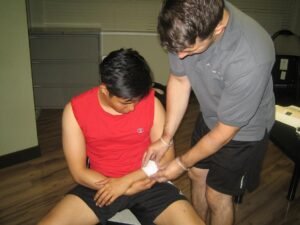A laceration is best described as an irregular cut in the skin from any sharp object. The treatment for a laceration typically depends on how deep the wound is. In most cases, it would require approximately up to 10 days for the wound to fully heal.
A laceration is basically a wound that is produced by the tearing of the soft bodily tissues. With this type of wound, it is often irregular and jagged in appearance. Take note that a laceration is often contaminated with debris and bacteria from the object that produced the cut. Lacerations that are small would only require minor treatment at home but the large ones would require emergency medical care.
First aid measures for a laceration
- Always stay safe. In case you are not the victim, it is important to practice universal precautions and use appropriate protective equipment if available.
- Initially, you have to control the bleeding. Apply pressure directly on the wound while supporting it higher than the level of the heart for about 15 minutes. This time is enough to put a stop to the bleeding. If this is not successful, you can utilize the pressure points. Always remember that using tourniquets must be avoided unless medical care could not be given right away.
- In case the bleeding could not be controlled, immediately call for emergency assistance.
- Once the bleeding is controlled, the wound should be washed using mild soap and warm water. If the bleeding starts again, you have to apply pressure.
- If the laceration is big enough to require stitches, it is best to go directly to the emergency department at the nearest hospital. As for small lacerations that do not need stitches, all you have to do is to apply an antiseptic ointment and close using butterfly closures.
- The wound should be covered using a sterile gauze and secure it in place or wrap with a roller gauze.
- Always observe for infection and regularly change the dressings on a daily basis. The wound should be cleaned every time you change the dressing. If there is swelling, redness or draining pus, it is best to seek medical care.
- For pain relief, over-the-counter medications such as ibuprofen or acetaminophen can be given.

Important considerations when treating a laceration
In case the laceration is contaminated, you have to consult a doctor right away so that a vaccination for tetanus or a booster shot can be administered. High risk of contamination is possible for wounds that could not be cleaned immediately, wounds at the foot or wounds from animal bites.
Always remember to call for emergency assistance right away if the cut is bleeding profusely, bleeding could not be controlled after 10 minutes of applying pressure and if the blood is spurting out excessively.
